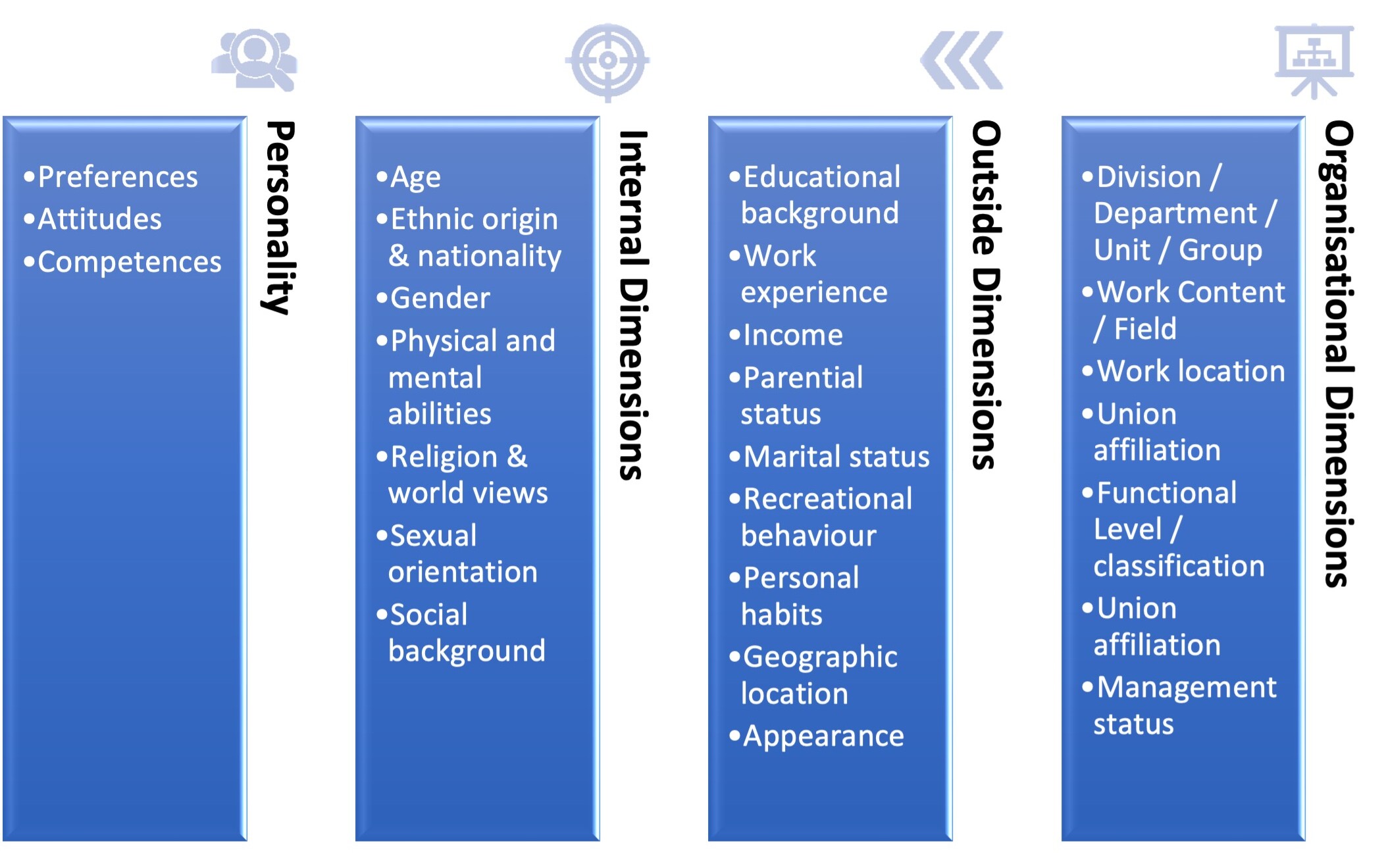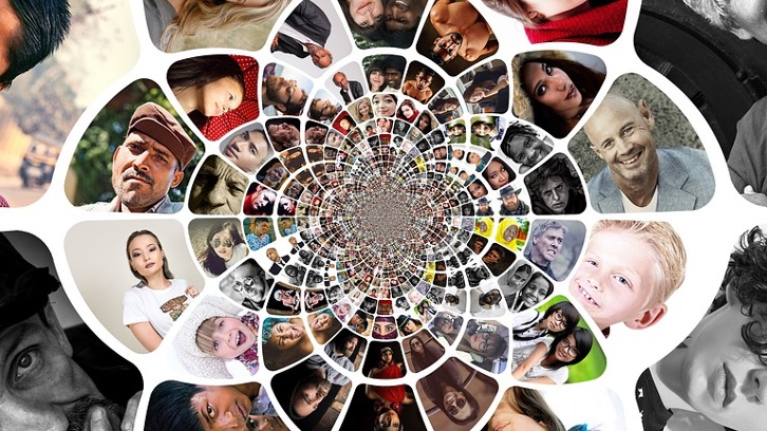Diversity in the company: In many organisations this means looking at the proportion of women and men at each hierarchical level. And when staffing project groups, make sure that old and young are represented, be it in terms of age or length of service. A good first step, but more is needed for beneficial diversity and inclusion.
“It’s always the same, when will we have something different for dinner?” I have no idea why the underage household member is complaining. The menu of the past five days has been very varied: maccheroni, fusilli, penne, tortiglioni and girandole – or in short: Barilla No. 44, 98, 73, 83 and 34, with mushroom-cream sauce, tomato sauce, cheese sauce, garlic-herb sauce and vegetable sauce respectively. That’s real variety in the kitchen – culinary diversity in action, so to speak… I think. But my counterpart has a completely different opinion and talks about rice, potatoes, buckwheat, millet. Aubergines, pumpkin, spinach, maize. Lettuce, cabbage, fennel, quinoa. Maybe someone is right?
Diversity criteria
Applied to an organisation, this means that limiting diversity to one or two criteria is better than spaghetti with tomato sauce every day. As long as it doesn’t remain a question of considering diversity only in terms of noodles – or only in terms of gender. For example, in a discussion about working hours or job bike offers, a criterion like the length of the way to work is more relevant. And in a project where implementation qualities are called for shortly before noon, those with a tendency to question or explore possibilities should rather not be there.
But what can diversity refer to? More than 30 years ago, Lee Gardenswartz and Anita Rowe developed the model of the Four layers of diversity. Since then, this has been a model and reference for activities around diversity.

Four layers of diversity [according to: https://www.gardenswartzrowe.com/why-g-r]
The first layer is that of personality:
- What are someone’s preferences? For example: Does she prefer to delve into specific details or look at possible connections?
- With what attitude does someone lead others? For example: Does he tend to defend his own opinion consistently even in the face of headwinds or does he give in quickly?
- Which competencies does someone draw on? For example: Can she quickly recognise the need for innovation or does she rather focus on the proven logic of the known?
By the way: We pick up on these levels of personality with the Power-Potential-Profile, our multidimensional potential analysis.
The second level, that of the internal dimension, is the most common in diversity activities in organisations. Among these criteria, the visible ones are particularly obvious to many, after all, you don’t have to ask anyone. You can see it, whether man/woman, old/young, light/dark-skinned. But the others mentioned in the table are at least as important for diversity in the company.
The third and fourth levels refer to aspects outside the person:
- Firstly, the location in society with criteria that largely determine a milieu affiliation;
- On the other hand, the location in the organisation along hierarchies and tasks.
The fine art of diversity management consists in varying the different criteria.
Diversity management is change management
In our consulting practice on diversity management, we usually experience astonishment at this point at the latest, combined with resistance. Astonishment at the complexity of the topic and resistance with regard to the assumed impossibility of implementation. Three comments on this:
- It is not a question of entering into a diversity outbidding competition according to the motto: The more of the 24 criteria mentioned in the figure are applied, the better the diversity management. Rather, the art lies in naming the relevant criteria depending on the task and situation. You should not do this alone, but always in a hopefully controversial exchange with ‘other’ others.
- Diversity, of course, also has something to do with reducing disadvantages. Not only those that relate to criteria of the core dimension. Then there is a second side to it. Namely, the opportunities for the organisation through professional diversity management: “The “deficit model” of eliminating disadvantages and avoiding disadvantages is expanded by the active element of creating strategic diversity. Homogenisation as a strategy of diversity management according to the motto “Nobody must be disadvantaged!”. is supplemented by building diversity according to the motto “As much diversity as necessary!” [Becker, p. 17] In this way, the organisation increases its own possibilities of perception and action and can consequently act better in complex situations.
- Diversity management is also always change management. Not only job advertisements and company guidelines should be changed, but also personnel policy and selection, team appointments and work organisation. Through these and many other measures, an organisation gradually changes in the direction of more diversity.
To make these three points mentioned – relevant diversity criteria, increasing diversity as a purpose, change management – effective, an organisation needs not only time but also resource buffers. And that fourfold:
- The opportunity to try out diversity;
- the competence (as an ability and a right) to engage in conflict;
- the protection against attacks and uncertain situations;
- the chance to experience diversity as a driver of innovation.
If this is guaranteed, people in and around the organisation can act in such a way that new diverse structures emerge.
Diversity is our passion. Inclusion is critical to your business.
This is the title of an entry on the website of Lee Gardenswartz and Anita Rowe. They are thus focusing on the second side of the coin:
- On the first side is diversity – the promotion, not just the acceptance, of diverse diversity.
- On the second side is inclusion – activating diversity for the benefit of the organisation.
Inclusion here is not the pedagogical term (the inclusive school as a school with impaired and non-impaired children), but the sociological one: inclusion as equal participation. Veronika Hucke explains the difference to diversity thus:
“Diversity is mixing, inclusion is making it work”, or “Diversity is inviting people to the party, inclusion is asking them to dance”. So it is not only important to employ different people in the company (diversity), but to ensure that they are valued, have equal opportunities and work together successfully (inclusion). This also shows that the term “inclusion” is broader than “equal opportunities”. [Hucke, p. 2f.]
Only in an inclusive way does diversity in organisations become a practical benefit. By the way, I like this idea very much for our home: If diversity in the kitchen means really bringing variety into the menu – doesn’t inclusion mean: everyone helps with the cooking? I’ll bring that up right away…
Becker, M. (2015): Systematisches Diversity Management. Konzepte und Instrumente für die Personal- und Führungspolitik. Stuttgart. [https://shop.haufe.de/prod/systematisches-diversity-management?] Hucke, V. (2017): Mit Vielfalt und Fairness zum Erfolg. Praxishandbuch für Diversity und Inclusion im Unternehmen. Wiesbaden. [https://link.springer.com/book/10.1007/978-3-658-16878-0]



